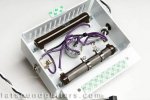i386
Captain
- Joined
- Aug 24, 2004
- Messages
- 3,548
Can someone identify the parts in this pic?
This is what I think I see...
It's a switch, a 1/4" mono phono jack, and 2 "special" resistors.
The top resistor has a single unknown value.
The bottom resistor is "tapped?" for 3 separate values.
The switch has 4 positions.
Is position 4 just the big resistor or both? Series or parallel? Better yet, can someone draw a schematic (minus the values or course).
I'll take whatever I can get. Thanks!
This is what I think I see...
It's a switch, a 1/4" mono phono jack, and 2 "special" resistors.
The top resistor has a single unknown value.
The bottom resistor is "tapped?" for 3 separate values.
The switch has 4 positions.
Is position 4 just the big resistor or both? Series or parallel? Better yet, can someone draw a schematic (minus the values or course).
I'll take whatever I can get. Thanks!




















